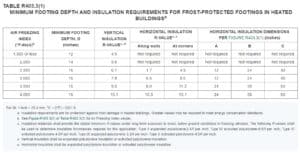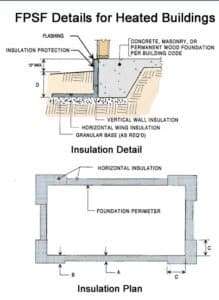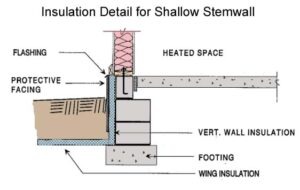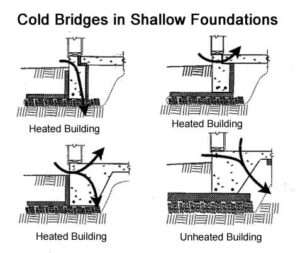Q: We are building a family home in Toronto, Canada using a local builder.
Due to soil conditions, we had to raise our founding level. The code requires the underside of footings to be 4 ft. below grade for frost protection. In our case with a sloping grade, the footing depth is 4 inches less than the required 4 ft in some locations.
The structural engineer’s opinion is that no additional frost protection measures are required since we have an 8 in. concrete mud slab below the footings. So there is no soil within 4 ft. of the bottom of the mud slab.
As an additional measure, the builder is recommending putting rigid foam that is 2 ft. vertical and 2 ft. horizontal above the footings and foundation. where it’s at a shallower depth. He is saying the cost is minimal and there are no real cons.
Please let me know your opinion. Are there are any cons to this approach and does it provide any long-term value? Not sure how effective rigid insulation would be around 2-4 ft. below grade. with wet soil conditions and other factors. Wouldn’t the foam just rot away over some time? Would it pollute the soil? Any other considerations? Not sure if its common practice and whether it’s effective in preventing frost risk. –Rick M.
A: There are two separate issues here:
1) Does your foundation need additional protection from frost damage?
2) Is this the best approach to achieve that?
Your engineer, who has been on site and knows the local soil conditions does not believe additional protection is required. If I understand you correctly, the footings sit on top of the mud slab, so the bottom of the concrete is really more than 4 ft. below grade so is not at risk. That makes sense to me.
However, if you want extra protection from frost due to extreme cold temperatures combined with wet soil, you may want to consider your builder’s approach as an upgrade. His approach is commonly called the Frost-Protected Shallow Foundation and is backed by extensive research in the US and Europe.
Frost-Protected Foundations
The approach of building shallower footings and protecting them with insulation was pioneered in Scandinavian countries after WWII, but now is accepted by the IRC (International Residential Code) and widely endorsed by the building industry, which has done a great deal of research on the topic.
The approach, referred to a Frost-Protected Shallow Foundations (FPSF) is mainly used with monolithic (thickened edge) slabs that can sit as little as 16 in. below grade in most of U.S. and southern Canada.
The general concept is that a combination of vertical and horizontal rigid foam placed around the foundation will create a warmer zone under and around the footings, protecting them from frost. The area below the insulation is warmed by the deep earth temperatures, which range from 50-60° F. throughout much of the U.S. and southern Canada.
The soil is also heated by heat loss from the building itself. In an unheated building, the same approach can work, but these generally require thicker insulation and wider horizontal “wings”.
How Much Insulation
There are many different configurations, depending on the foundation type, but the key is to have a continuous layer of vertical and horizontal insulation that isolates the foundation wall and footings from the exterior air.
The minimum thickness and width of insulation to prevent frost heaves is determined by the Air Freezing Index, compiled from heating -degree-day data. For the two most common slab configurations, a thickened-edge slab and a stem wall, use Table R403.3 below. Similar insulation details can be used around posts and piers to limit their depth in cold climates.



Installation
I prefer to use extruded polystyrene insulation (XPS), which is the most durable foam insulation buried in the ground. However, higher densities of expanded polystyrene (EPS) can also work well. The foam R-value is reduced somewhat for losses over time. For example, XPS is lowered from R-5 to R 4.5 per inch.
It is important to install the insulation with care so that it is not damaged when placed or backfilled. Because concrete is highly conductive, even modest gaps can cause thermal short-circuits or “cold bridges” that lead to cold spots in the soil or slab edge. In the worse cases, this could undermine the frost protection and lead to frost heaves in the area of the cold bridge (illustration below).

Foam Durability and Green Credentials
To what extent will foam be damaged by insects, frost, and general wear and tear over the years? Probably to some extent, but most studies have found only minor degradation after 20-30 year or more – for both XPS and higher densities of EPS.
In areas subject to subterranean termites, it would be wise to treat the soil or use treated foam as termites seem to use the soft foam for housing and protection, although they do not eat the foam. (Above grade., carpenter ants also find foam board an attractive home.)
Since it is inert, foam should not affect the soil. On the other hand, it’s not environmentally benign because
- It is made from petroleum
- It is manufactured using CFCs and HCFCs, which contribute to global warming
- Because of its durability, it is hard to recycle
EPS foam uses pentane as a blowing agent, which is not considered a significant contributor to global warming.
A final point to consider is landscaping. Deep-rooted plants may not do well planted in soil only two feet deep. But holding plants away from the foundation by a few feet is not a bad thing – it’s usually better for drainage away from the house. — Steve Bliss, Editor, BuildingAdvisor.com
For a comprehensive design guide to shallow foundations, download the Revised Builders Guide to Frost-Protected Shallow Foundation, NAHB Research,
For additional information:
HUD Design Guide for Frost-Protected Shallow Foundations
IRC Section R403.3 Frost-Protected Shallow Foundations
Canadian guide to Insulated Slab Foundations
Also read more on Foundation Insulation
Ron Desrosiers says
Can I Protect Shallow Footings With Rigid Foam in Wet Soil?
I am building a bungalow in Northern Ontario with ICF foundation and would normally excavate to 5ft to place footings. Because of higher water table I cannot dig as deep and am considering digging 3 ft and protecting footings with 2′ x 4′ or 8′ rigid foam insulation. Can you advise on this alternative. What does 2″ or 4″ thick rigid board insulation replace in terms of digging depth?
Thank you
buildingadvisor says
The short answer is, Yes, you can generally use shallower footings if they are protected properly by rigid foam foundation. This approach, called the Frost Protected Shallow Foundation, requires an adequate thickness of vertical and horizontal foam with no gaps or “cold bridges” (see original article). However, there is no simple formula that says X amount of insulation saves you Y amount of depth.
The table in the article above was developed by complex computer modeling of heat loss below grade. Unfortunately, the table only goes to an air freezing index of 4,000 degree days F, while northern Ontario has an air freezing index of 5,000 to 6,000 degree days F.
A similar Canadian Guide to Insulated Slab-on-Grade Foundations, covers most climates up to 7,700 heating degree-days C, so it should provide suitable details for your area.
The general concept is that horizontal rigid foam will create a warmer zone below the insulation due to the warming action of deep earth temperatures – about 50-60 degrees F in most of the US and Canada. The vertical insulation prevents cold bridges and heat leaks that could bypass the horizontal insulation and freeze the soil.
Different insulation details are required for heated vs. unheated buildings as this will affect soil temperatures and the potential for frost damage. Also the tables assume well-drained soil. Soil with high silt or clay content and a high water table would tend to be frost-active and may not be suitable for a shallow foundation. You may need to get input here from a soils engineer.
For a frost-protected foundation, choose a foam insulation that is very durable buried in the ground, install it carefully, and protect it with a sufficiently thick layer of gravel and soil above. Will it be damaged by insects, frost, and settling over the years? Probably to some extent, but most studies have found only minor degradation after 20-30 years. And since the foam is inert, it should not affect the soil. I prefer extruded polystyrene foam (XPS), but higher density EPS can work as well.
For detailed design information, download:
Builders Guide to Frost-Protected Shallow Foundations
Guide to Insulated Slab-On-Grade Foundations (Canadian)